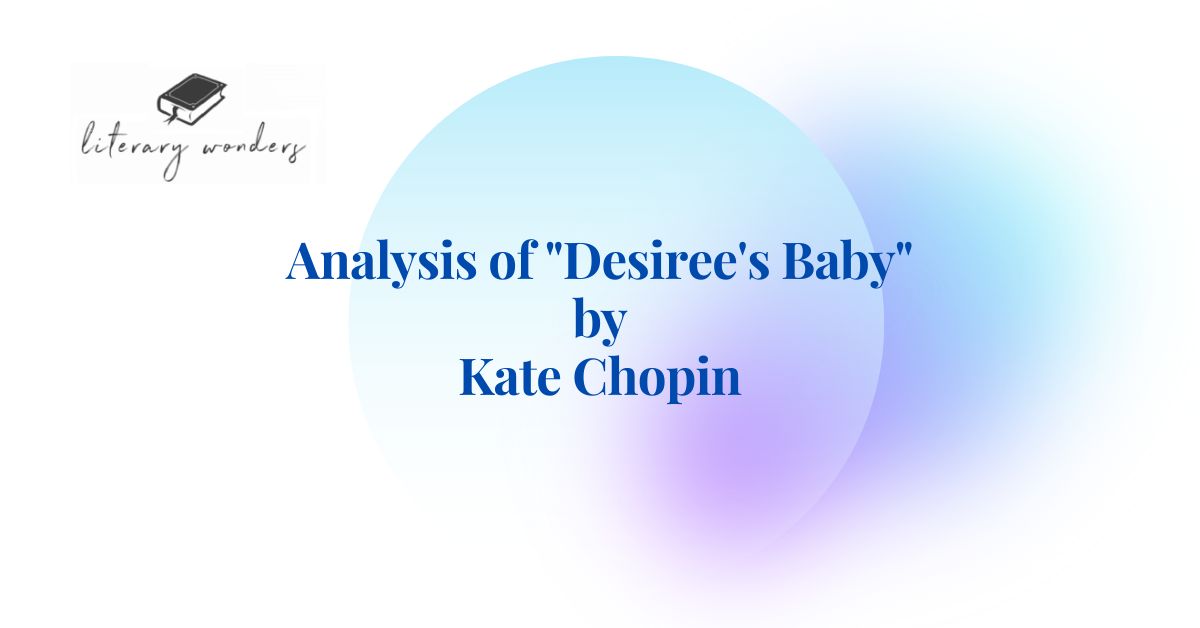Summary of “Desiree’s Baby”
Written in the 19th century, Kate Chopin’s “Desiree’s Baby” is a poignant tale that explores the complicated themes of race, identity, and prejudice in late 19th-century Louisiana. The story revolves around Desiree, a young woman abandoned as a baby and raised by Madame Valmonde. When Desiree grows up, she falls in love with Armand Aubigny, a wealthy plantation owner, and marries him. They have a child together, but Armand begins to suspect that the child is not white as the baby grows older.
Armand’s suspicions are confirmed when he discovers a letter from his mother that reveals that his father was part black. Horrified and ashamed, Armand blames Desiree for the baby’s mixed-race heritage and demands that she and the child leave the plantation. Desiree is devastated and confused by Armand’s sudden change of heart, but she agrees to go with the baby.
As she wanders aimlessly through the countryside, Desiree becomes increasingly desperate, realizing that she has no home, family, or means of support. She eventually comes across a bayou, where she and the baby drown. Armand is left alone, tormented by his guilt and regret.
Analysis of the Story
“Desiree’s Baby” by Kate Chopin is a powerful commentary on the social and cultural dynamics of the era. The writer highlights the prejudices and injustices of a society that is divided along racial lines, where people are judged and ostracized based on their skin color. The story exposes the cruelty and hypocrisy of a world that values appearance over substance and where the truth is often hidden or ignored to preserve the status quo.
One of the story’s key themes is identity and knowing one’s true heritage. Armand’s sense of identity is shattered when he discovers the truth about his father, and he cannot reconcile his racial background with his status as a wealthy white plantation owner. Desiree’s identity is also called into question as she is forced to confront the possibility that she may not know her true ancestry.
Another important theme is the notion of power and control and how these dynamics play out in relationships. Armand exerts his power over Desiree, treating her as a possession rather than a partner, and he ultimately uses his position of privilege to cast her and the baby out. On the other hand, Desiree is a victim of circumstance and is powerless to resist the forces that conspire against her.
Significance of “Desiree’s Baby”
The story is significant in several ways. First and foremost, it highlights the insidious nature of racism and how it can affect even those unaware of their racial identity. The fact that Armand, who prides himself on his pure white ancestry, could not accept his child for being of mixed race underscores the depth of racial prejudice in the antebellum South.
Moreover, the story also underscores the theme of female oppression and how women were often subjugated to the whims of men. Desiree, despite her innocence, is forced to leave her home and her child because of Armand’s cruel actions. Her tragic fate highlights women’s lack of agency in the past and serves as a cautionary tale about the need for women’s empowerment.
The setting of the Story
The story is set in the early 19th century in Louisiana, USA. The story takes place on a plantation owned by the Valmonde family, where Desiree, a young and beautiful woman, is found abandoned as a child. The Valmondes adopt her, and she grows up to marry Armand Aubigny, a wealthy plantation owner. The story is set against the backdrop of the deep-seated racial prejudices in the South, where skin color determines one’s social status. The plantation is surrounded by vast sugarcane fields, with a sprawling mansion at its center, while the slaves work tirelessly under the hot sun.
Conclusion
The analysis shows that “Desiree’s Baby” is a haunting and thought-provoking story that raises important questions about the nature of identity, power, and prejudice. It is a reminder of the dangers of a world divided by race and class and the need to seek truth and understanding to break down these barriers.
Suggested Readings

